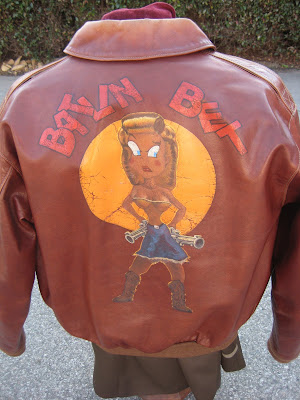
So, whatever happened to the 24 year old Fighter-Jock/Artist/Warrior Hero named Kenny Frost?
After flying his 50 combat missions in the European Theater, Kenny came back to the United States for his required six months stateside service. After spending six months stateside he could then be eligible to fly in the Pacific Theater against the Japanese.
During his stateside service he was stationed at Dagget Army Air Force Base out in the Desert near Barstow. His job was to fly as an instructor in P-38's; teaching other pilots the art of firing rockets in their bombing/strafing runs.
On Sept. 17, 1945, one month after the end of WWII, Kenny was instructing four other pilots in the firing of rockets out on a dry lake bed near Ft. Irwin. While the four students flew in a pattern above the range, at an elevation of 6500 feet, Kenny winged over and flew a dry run at a target airplane on the edge of the dry lake bed.
Now, usually when rockets are fired at a target on the ground the pilot's job is to pull up from his decent so he doesn't get plastered by the explosion. He doesn't get a chance to see the rockets hit. One day Kenny was overheard saying he was determined to, "see the rockets hit" by firing the rockets, then diving below their trajectory, and pulling up behind and underneath, so he could see them hit the target.
On his first dry run, he dove from 6500 feet, dry fired, dropped down lower than normal and pulled out, but at an incredibly low altitude, at a high rate of speed; so low that the range master immediately radioed Kenny and chewed him out, saying he was to," never, ever try that again!"
However, as fate would have it, one of the four students flying and observing in the pattern had their microphone stuck in the "open" position, and Kenny never got the warning from the range master. Kenny, after his first dry run began his ascent up to the pattern altitude again. According to the Range Master at 3600 feet Kenny winged over and proceeded on his second dry run.
The Range Master knew immediately Kenny was a goner and rushed out to scramble the emergency vehicles. Kenny proceeded on his dry run but misjudged his speed and altitude. At a high rate of speed, Kenny attempted to pull out of his dive, but stalled his P-38 and "Mushed" it in. It was a high speed stall. As he stalled, one wing tip hit the desert floor and the plane cartwheeled, (or ground looped), and burst into flames. Wreckage was scattered over a mile.
With the help of AAIR (Aviation Accident Investigation Research) I made contact with the Colonel in charge of Ft. Irwin Military Base. I made arrangements to come out to the base to find the crash site, along with historian Steve Blake, AAIR, and the Ft. Irwin Base Historian, to go out to the dry lake bed to find the crash site. On the day we arrived for the archaeological dig, the Base Colonel granted us an escort of Humvees. He also came along for the ride.
We took a ride out to the area where we thought the crash had taken place. Via the use of satellite imagery, and four black and white photos (which were taken at the crash site the afternoon of the crash), we could see the desert landscape had hardly changed at all from what it looked like over sixty years ago.
We located the area where the target plane sat, and then spread out and walked in a southerly direction. We were on the verge of finding something that had been lost and forgotten over 60 years.
















